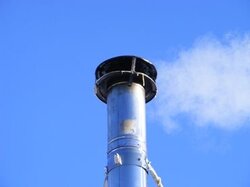R&D;Guy said:Clean it out every spring and I'm sure you'll be fine.
Do you get smoke in the room when you open the door on your woodstove? I'd think having 3-90's would put so much restriction on your flue that you'd get a lot of smoke in your house each time you open the door. Really bad air in your home could be bad for your health too. I had 2 vertical 90's on my woodstove in my last house so I could use a masonary chimney and if I opened the door at any speed except super-slow I'd get smoke spilling into the room. I never liked that, and I'm sure it added to a lot of bad air in the house.
As far as chimney fires, as noted I think you'll find it to be a issue of home owners who never clean their pipe. At the end of the year, clean it yourself and I think you'll see its a very small about of build up.
Also as noted, adding 45° offsets would add less restriction than your's 90's.
I dont have any smoke coming into the room when I open the door or draft issues, I did have a catastrophe on start up one day as I have an HRV system in my home and it was on when I was trying to light the stove, combatting a negative draft is a little hard with an HRV on and a house sealed extremely tight. Once I figured out to turn the HRV off when using the stove and cracking a door on start up I have no issues with smoke spilling back in, the positive draft is very strong. I will look into the 45's as opposed to the 90's hadn't thought of that. Thanks


 I have 8ft of exposed chimney. I clean it once a year with the latest stove. The other was every two months. :coolmad: BURN DRY WOOD thats the key. If you purchase a stove with secondary burn non cat than make sure your getting it to run that burn on every cycle. Even if you have to open a window. That was my earlier mistake.
I have 8ft of exposed chimney. I clean it once a year with the latest stove. The other was every two months. :coolmad: BURN DRY WOOD thats the key. If you purchase a stove with secondary burn non cat than make sure your getting it to run that burn on every cycle. Even if you have to open a window. That was my earlier mistake.
